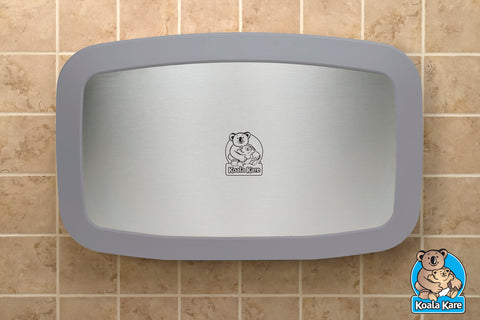 How Many Changing Stations are Necessary?
How Many Changing Stations are Necessary?One of the most common issues people run into when installing a baby changing station is not having enough to serve the amount of children that are cared for in a building. This can be avoided by assessing the traffic flow in an area so the correct amount of changing stations can be purchased. For daycares, one changing table per eight infants is generally sufficient. However, it is also a good idea to plan to include an additional changing station in any adult restrooms for parents to use if one is occupied in the classroom. Other public spaces, such as airports and entertainment venues, may need to install more than one changing station in each bathroom. This is especially true if a high number of children are expected in the area.
Where Should They be Placed?
In addition to purchasing the correct amount of baby changing stations, it is also important to plan for the proper placement in a restroom facility or daycare classroom. Begin by assessing the current layout of the bathroom or classroom to identify areas that should not be blocked by a changing station. Although baby changing stations fold up when they are not in use, it is important to make sure they do not interfere withwheelchair access when someone is changing a baby. For safety purposes, it is also important to ensure they are not located near hot hand dryers or over garbage containers. In the past, baby changing stations were only placed in women’s restrooms; however, including them in men’s restrooms will ensure that everyone has access to a hygienic area to tend to a child’s needs.

Once the layout has been planned, it is important to measure to ensure that the station will fit into the area while allowing enough space to maintain traffic flowwhen it is opened. Using theKB200-SS model as an example, a person should plan for the station to take up 4-inches of space when it is closed and approximately 24-inches when it is opened. Finally, be sure to account for the additional space used by the person operating the station. In most restrooms, the compact nature of this model will fit into any layout.
Is it Durable Enough to Last While Maintaining Style?
Including a baby changing station in any area that is frequented by heavy traffic requires paying close attention to the materials from which a changing station is made. For daycares where most diaper changes are completed a staff or parents a polyethylene unit will be sufficient. However, in high traffic applications with a high risk of abuse a stainless steel unit is recommended.
Here are a few of the other features to look for that will point to a quality changing station that can go the distance:
- Steel hinges for wear-resistance
- Inner-cavity locks to deter vandalism
- Child-protection straps
- Antimicrobial bed surface to ensure hygiene
- Ability to support the weight of older children
In addition to the many special features that are available for ensuring durability, it is also important to consider how the changing station fits into the overall decorating scheme. Baby changing stations are available in several different colors including white granite, grey, beige and brown. When choosing the color that works best in a classroom or restroom, it is important to consider the other fixtures included in the space. This will ensure that the baby changing station blends into the space while contributing to the overall aesthetics.
Parents and other caregivers appreciate the thought that goes into planning for and purchasing baby changing stations that can make tending to their children easier and more hygienic.
Parents and other caregivers appreciate the thought that goes into planning for and purchasing baby changing stations that can make tending to their children easier and more hygienic.
1 Comments
Posted by test on November 02, 2013
Best